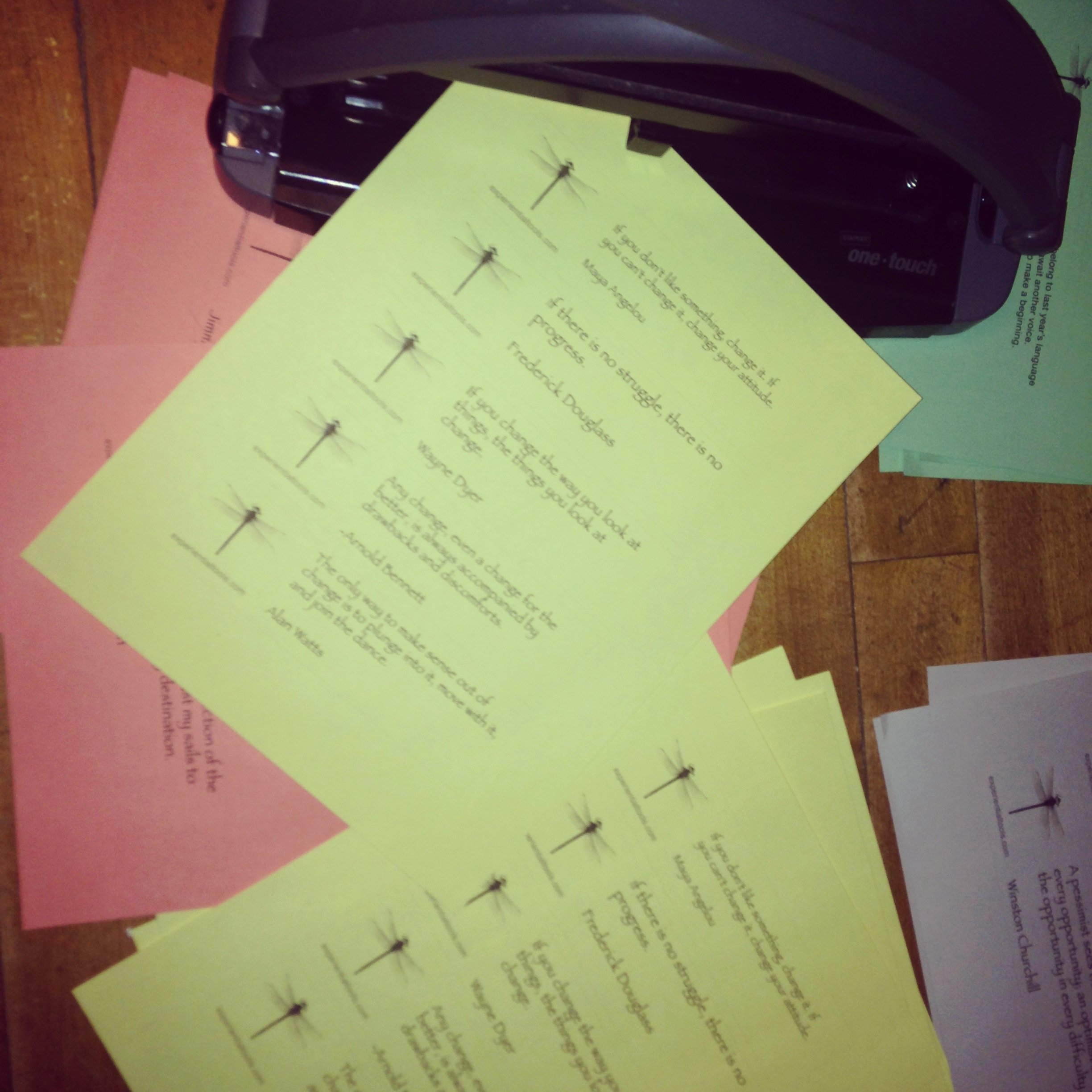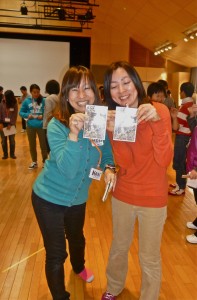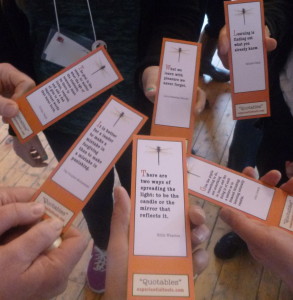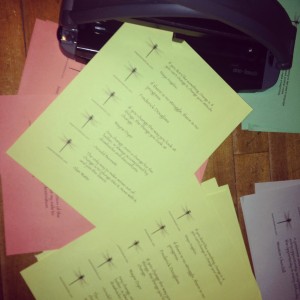
Jan 07, 2014 Strong Beginnings: Find a Hook to Engage Your Groups!
This evening as I sit cutting out quotes with “new year” and “new beginnings” themes in preparation for some upcoming workshops, I have been reflecting on the power of strong beginnings. Here is an excerpt from my upcoming book Inspired Educator, Inspired Learner that explores this subject.
Think back to your most memorable learning experiences, the courses you enjoyed, and the teachers/facilitators you found most effective. How did they start their classes or workshop sessions? How did they greet you when you came into their classroom? Chances are they intentionally planned to draw you into the learning experience.
Many educators do this instinctively. We consider ourselves hosts to the participants or students joining us for a learning experience. For years I have been using objects, postcards, quotes and entry tasks such as writing prompts, reflective partner conversations, or a daily puzzle as a way to welcome and engage group members from the moment they walk in the door. These methods involve the group in a meaningful learning experience while at the same time allowing me to take care of administrative duties such as adjusting room set up or materials, taking attendance or collecting homework.
In the U.S., people are often late to workshops and the entry time from the first person arriving to the last can extend for 20 minutes or more (though I found this was not the case in my recent travels to Japan. If a workshop is scheduled to start at 9:00 there it truly does!). Using an entry activity leaves me free to set up or greet the late arrivals and makes me feel like a better host. Now that I am paying close attention to research in the field of educational neuroscience, I realize that this strategy can be considered a valuable “evidence informed practice” that transfers to day-to-day classroom teaching and training programs. Intentionally creating an engaging and novel start to a session has many benefits to learners.
 Proponents of brain-based learning emphasize that events that happen the first time learners are exposed to information greatly impact their ability to accurately retain the information. John Medina, author of Brain Rules states: “If you are trying to get information across to someone, your ability to create a compelling introduction may be the most important single factor in the later success of your mission.” (Medina, 2008, p.116). The first few minutes of an experience or lesson are a key time to hook and engage learners. Educational psychologists have demonstrated that people remember most the first few minutes of a learning experience and the last few minutes of learning experience (Sousa, 2006, Willis, 2010). Psychologists call this the primacy-recency effect. This underscores the importance of facilitating an engaging opening activity as well as providing some reflective prompt to tie it all together or “bookend” a learning experience. This suggests that it also might make sense to create as many introductory and closing moments as possible in your teaching and group facilitation.
Proponents of brain-based learning emphasize that events that happen the first time learners are exposed to information greatly impact their ability to accurately retain the information. John Medina, author of Brain Rules states: “If you are trying to get information across to someone, your ability to create a compelling introduction may be the most important single factor in the later success of your mission.” (Medina, 2008, p.116). The first few minutes of an experience or lesson are a key time to hook and engage learners. Educational psychologists have demonstrated that people remember most the first few minutes of a learning experience and the last few minutes of learning experience (Sousa, 2006, Willis, 2010). Psychologists call this the primacy-recency effect. This underscores the importance of facilitating an engaging opening activity as well as providing some reflective prompt to tie it all together or “bookend” a learning experience. This suggests that it also might make sense to create as many introductory and closing moments as possible in your teaching and group facilitation.
The reticular activating system (RAS)—the brain’s sensory intake filter through which all sensory input must pass—is very receptive to novelty and change, and responds to pleasure and sensory input that arouses curiosity (Willis, 2010). Novelty and curiosity evoking events alert the RAS system to pay attention because there is something new or different that warrants further evaluation (Aamodt & Wang 2011).
Find a Hook!
 Find a Hook! Engage learners from the moment they walk in the door. Involve participants/students in an activity that helps them transition positively into the learning environment rather than using these precious moments to focus solely on taking attendance, collecting homework, or other administrative duties. This can be a time for them to make positive connections with their peers, explore or review the academic material at hand, create context around a lesson, and most importantly, shift their focus to the here and now.
Find a Hook! Engage learners from the moment they walk in the door. Involve participants/students in an activity that helps them transition positively into the learning environment rather than using these precious moments to focus solely on taking attendance, collecting homework, or other administrative duties. This can be a time for them to make positive connections with their peers, explore or review the academic material at hand, create context around a lesson, and most importantly, shift their focus to the here and now.
Coming together for the first time can feel awkward for some participants. A novel activity engages learners right away and helps draw them into a positive experience and creates buy in, thereby increasing engagement. Learners of all ages come to the classroom with things on their mind — whether it was a stressful commute, a rough morning at home, a negative social interaction in the hallway before class, or the exam coming up next period. A reflective focusing activity can help learners transition into the classroom space and shift their focus to the present and the lesson at hand.
 People are drawn in by colorful, novel, or intriguing objects whether they are tools, old toys, or items found in nature. People often share and reflect more readily when they can attach their thoughts and feelings to an item that can be touched and shown to a group during discussion, or described in reflective writing. Brain research suggests that using metaphors, pictures and symbols helps cement lessons and transfer learning to everyday life future learning (Willis, 2006, 2010). In many past blog posts I have offered activities to do just this!
People are drawn in by colorful, novel, or intriguing objects whether they are tools, old toys, or items found in nature. People often share and reflect more readily when they can attach their thoughts and feelings to an item that can be touched and shown to a group during discussion, or described in reflective writing. Brain research suggests that using metaphors, pictures and symbols helps cement lessons and transfer learning to everyday life future learning (Willis, 2006, 2010). In many past blog posts I have offered activities to do just this!
Here a few to explore:
Dominoes, Match Game Cards, and other Simple Tools to Engage Your Groups
More Ideas to Engage Learners as the Moment They Walk in the Door
Using Quotes to “Hook” Your Group’s Attention
Our Newest Resource “Quotables” Hot Off the Press!
The Power of Using Objects, Pictures and Other Metaphoric Methods in Teaching and Group Facilitation
References:
Medina, John. (2008). Brain Rules: 12 Principles for Surviving and Thriving at Work, Home and School. Seattle, WA: Pear Press.
Sousa, David. (2006). How the Brain Learns. Thousand Oaks, CA: Corwin Press.
Willis, Judy. (2006). Research-Based Strategies to Ignite Student Learning. Alexandria, VA: ASCD.




No Comments